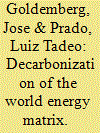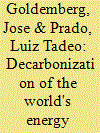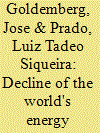|
|
|
Sort Order |
|
|
|
Items / Page
|
|
|
|
|
|
|
| Srl | Item |
| 1 |
ID:
097471


|
|
|
| 2 |
ID:
096633


|
|
|
|
|
| Publication |
2010.
|
| Summary/Abstract |
Decarbonizing" the world's energy matrix is the strategy being implemented by most countries to reduce CO2 emissions and thus contribute to achieve the ultimate objectives of the Climate Convention. The evolution of the carbon intensity (Ic=CO2/GDP) in the period 1990-2007 was encouraging but not sufficient to reduce the growth of carbon emission. As a result of COP-15 in Copenhagen these countries (and regions) made pledges that could lead to more reduction: for the United States a 17% reduction in CO2 emissions by 2020 below the level of 2005; for the European Union a 20% reduction in CO2 emissions by 2020 below the 1990 level; for China a 40-45% reduction in the carbon intensity and for India a 20-25% reduction in carbon intensity by 2020. We analyzed the consequences of such pledges and concluded that the expected yearly rate of decrease of the carbon intensity follows basically the "business as usual" trend in the period 1990-2007 and will, in all likelihood, be insufficient to reduce carbon emissions up to 2020.
|
|
|
|
|
|
|
|
|
|
|
|
|
|
|
|
| 3 |
ID:
118823


|
|
|
|
|
| Publication |
2013.
|
| Summary/Abstract |
The world's primary energy consumption in the last 40 years has been increasing at 2.2%/year while GDP growth has been 3.4%/years over the same period. The decline of the energy intensity (I=E/GDP) has been, therefore, of 1.2%/year. In order to reduce the world's consumption growth proposal have been made to reduce the world's energy intensity by 40% by 2030 which corresponds to a reduction of 2.5%/year, roughly the double of the historical decline. Our analysis shoes that such goal could only be achieved by an unprecedented reduction of the energy intensity of "services" (which represent less than half the world energy consumption) since energy intensity of industry has remained practically constant in the last 40 years.
|
|
|
|
|
|
|
|
|
|
|
|
|
|
|
|
| 4 |
ID:
103488


|
|
|
|
|
| Publication |
2011.
|
| Summary/Abstract |
Energy intensity of the total primary energy supply (TPES), total final energy consumption (TFC) and LOSSES in the conversion from TPES to TFC were analyzed for the World, OECD and Rest of the World (ROW) countries. LOSSES increased significantly for all groups of countries due to the increase of electricity production from coal in the period studied (1971-2008). Electricity share final consumption almost doubled, increasing from 8.8% to 17.2% in the period studied. However the energy intensity of LOSSES remained practically constant, which reflects the fact that the efficiency of electricity generation from coal (the main source of electricity) remained practically constant in that period. Despite the attractiveness of end-use devices running on electricity such as computers, which is typical of modern societies, the CO2 emissions are bound to increase unless coal is replaced by less carbon emitting sources such as natural gas, renewables and nuclear energy.
|
|
|
|
|
|
|
|
|
|
|
|
|
|
|
|
| 5 |
ID:
125619


|
|
|
|
|
| Publication |
2013.
|
| Summary/Abstract |
Energy access has been singled out by the AGECC in 2010 as one of the important problems to be tackled in the next few decades in a world where 1.3 billion people do not have access to electricity and 2.7 use primitive fuels - mainly fuel wood - for cooking and heating.
To solve such problems, innumerous small scale projects have been implemented around the world either on the improvement of cooking stoves, biogas and others, as well as in generating electricity in decentralized systems.
We discuss here the "large scale approach" to solve these problems in Brazil through the introduction of LPG (liquid petroleum gas) in Brazil 70 years ago, all over the country, as a cooking fuel that replaced significantly the use of fuel wood in rural areas. In addition to that, we describe the governmental program (Luz para Todos - LPT - Light for all) introduced more recently to extend the electricity grid to around 10 million people, reducing considerably the number of people without access to electricity in the rural areas of the country.
Such experiences and the corresponding lessons learned could be replicated in other developing countries, contributing significantly to poverty alleviation.
|
|
|
|
|
|
|
|
|
|
|
|
|
|
|
|
| 6 |
ID:
171407


|
|
|
|
|
| Summary/Abstract |
The evolution of the energy intensity (TPES/GDP) and the carbon intensity (CO2/GDP) was investigated in the period 1990–2014. The universal tendency is a steady decline for all groups of countries (low, lower middle, upper middle and high income) with very few exceptions. Economic development as measured by GDP has been “decoupled” from total primary energy supply (TPES) and CO2 emissions in all regions of the world. The main drivers for such decline are discussed particularly the role of technological “leapfrogging”. Carbon emissions are growing faster than total primary energy supply (TPES) in the world as a whole and in the lower and upper income group of countries but declined in the high and low income groups. The early adoption of adequate policies determines the amount of decoupling, energy efficiency and the increased use of renewable being the dominant options. There are examples of countries which developed without increasing CO2 emissions and there is no reason to believe it could not be done in many developing countries.
|
|
|
|
|
|
|
|
|
|
|
|
|
|
|
|
| 7 |
ID:
132638


|
|
|
|
|
| Publication |
2014.
|
| Summary/Abstract |
The 2013 renewable energy policy mandates adopted in twenty-seven countries will increase the need for liquid biofuels. To achieve this, ethanol produced from corn and sugarcane will need to increase from 80 to approximately 200 billion l in 2021. This could be achieved by increasing the productivity of raw material per hectare, expansion of land into dedicated biofuels, or a combination of both. We show here that appropriate land expansion policies focused on conservationist programs and a scientific basis, are important for sustainable biofuel expansion whilst meeting the increasing demand for food and fiber. The Brazilian approach to biofuel and food security could be followed by other nations to provide a sustainable pathway to renewable energy and food production globally.
|
|
|
|
|
|
|
|
|
|
|
|
|
|
|
|
| 8 |
ID:
091927


|
|
|
| 9 |
ID:
126809


|
|
|
|
|
| Publication |
2014.
|
| Summary/Abstract |
A large share of Brazil's current investments is concentrated in the development of petroleum resources in new frontiers. Perspectives for large offshore pre-salt fields are particularly good. However, challenges are also huge. On one hand, pre-salt resources development will draw vast amounts of economic and human resources and pose significant macroeconomic risks. On the other hand, the petroleum industry can generate multiplicative effects into the country's economy and, even more importantly, generate rents that can be diverted towards the promotion of renewable energy sources. This paper simulates the rent generation of Brazil's petroleum development up to 2030 according to: the country's current fiscal regime, projections of petroleum supply and a probability analysis of Brent price evolution, and assesses how these economic resources, if properly allocated, can pave the way for an increased use of renewables in Brazil. Findings show that an ambitious energy innovation program based on a target-oriented agency plus a program for solar development would cost less than half the minimum average annual petroleum rent free for investing in renewables between 2013 and 2030. The remaining budget could improve the security of ethanol fuel supply, by avoiding the negative impacts of sugar prices spikes on Brazil's ethanol production.
|
|
|
|
|
|
|
|
|
|
|
|
|
|
|
|
| 10 |
ID:
125552


|
|
|
|
|
| Publication |
2013.
|
| Summary/Abstract |
In an editorial of a recent issue of a known academic journal, Prof. Hartmut Michel affirmed that "…the production of biofuels constitutes an extremely inefficient land use… We should not grow plants for biofuel production.", after comparing the area occupied with plants for bioenergy production with the one required for photovoltaic cells to supply the same amount of energy for transportation. This assertion is not correct for all situations and this comparison deserves a more careful analysis, evaluating the actual and prospective technological scenarios and other relevant aspects, such as capacity requirements, energy consumed during the life cycle of energy systems and the associated impacts. In this communication this comparison is revaluated, presenting a different perspective, more favorable for the bioenergy routes.
|
|
|
|
|
|
|
|
|
|
|
|
|
|
|
|
|
|
|
|
|